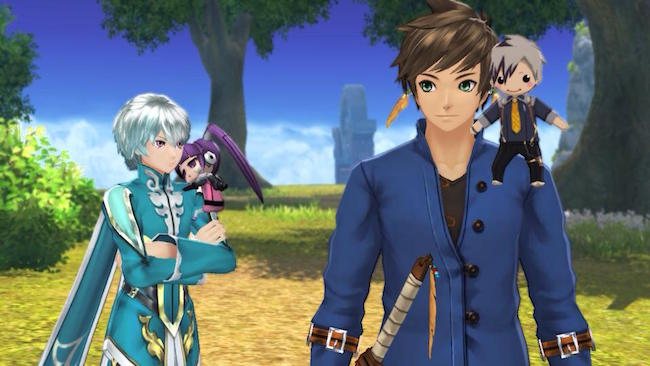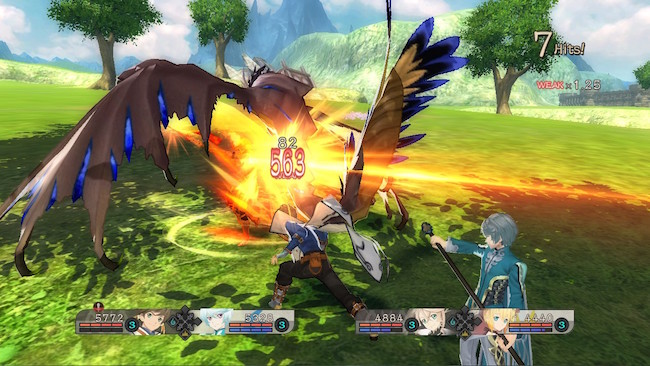
I’d be the first to admit I’m a bit of an anomaly in the realm of JRPG games. Despite being quite an enthusiastic anime fan for nearly ten years now, I’ve always struggled to commit to a JRPG from start to finish. Instead, a plethora of classic and contemporary titles sit on my shelves unplayed – because the one thing I love about JRPGs is what also drives me away from sinking my teeth into them. So what better way to finally finish one that I’d been interested in by metaphorically strapping myself into an armchair and writing a review? There’s no better way!
As the 15th installment in the Tales of series, Zestiria hit shelves last month with the usual fanfare reserved to one of the most famous JRPG lineages alongside Final Fantasy, Dragon Quest, Fire Emblem and a score of others. What automatically caught me in a pinch as I played through the first few hours, was something I’ve experienced in the anime medium before many times – the repurposing of Western mythology in a Japanese setting. I’ll be the first to raise my hand and admit that I’m usually a sucker for it, and Zestiria seemed to do it in a very shameless way – for example, the main character Sorey quickly discovers he is the Shepherd, essentially the chosen one. He makes his way to the city of LadyLake, where he pulls a sword out of a stone to make a contract with a spirit named Lailah. Sound familiar? Japan really seems to love the tale of King Arthur, and Zestiria is definitely not the first to borrow upon the famous tale – with other animes such as the Fate/Stay & Zero series alongside Code Geass just being a few among many.

One of the striking features that I really love in modern games is world expansion through audio/video collectibles, which in the instance of Zestiria came in the form of “Iris Gems” which contained the Earthen Historia. Through collecting them, Sorey and his seraph (angel) companions are able to piece together the story of past shepherds – and the rise and fall of past political dynasties. It’s a great way to deliver information without overloading players and allows the foundation of the world to be established slowly around you rather than bombarding you all at once. While I’d love to share more information, I’m trying to keep this review relatively spoiler-free as the game is still fairly new – so I apologise if the details at points are a little vague!
While Japanese RPGs have been criticised in the past for overly convoluted equipment and spell systems, Zestiria was very straightforward and easy to manage. Equipment was easily changeable, and a very simple fusion system was implemented in order to allow players to upgrade their gear – as well as align the spell properties onto a table depending on how you wanted each character to be built. While I did struggle a little to begin with, I very quickly figured out what to do as it became 2nd nature to repeat this many times over the course of the game.

Another integrated system that I didn’t play around with a great deal were character costumes – as you continued to play the game, you would come across more items to dress your characters in such as bunny ears and top hats. Call me old fashioned, but I found this sort of system incredibly repelling – if my character changes appearance, I’m used to it being because of changes in equipment rather than additional costumes.
For the most part, the game handled incredibly smoothly – and impressively, I came across no glitches in the entire playthrough, so my hat goes off to the developers for releasing a very polished product upon release. If I was to be critical of anything, I do feel the controls of the combat system could be a little more streamlined. Too often, I found trying to change my enemy aim in real time combat quite frustrating and difficult to do, which would end up with Sorey chasing his enemies repeatedly across the battlefield. Given the grind-heavy nature of JRPGs, this got incredibly irritating towards the end of my play through – and I feel given the nature of other titles combat systems, this perhaps could have been a tad more intuitive.

In a shout out to any anime fans out there, I would recommend giving Tales of Zestiria a serious look. Funnily enough, a stand-alone TV Movie episode was actually made featuring the prologue of the game – so if you’re curious to see what the story and characters are like, then that’s an excellent opportunity to be able to do so. The art is fantastic, and it was a real treat to play it on current gen graphics – it looks great on the PS4, and for those with high-performance PCs, I can imagine it would be an even more aesthetically pleasing experience.
Being that I watch subbed anime, I decided to go with the Japanese audio and subtitles – and I wasn’t disappointed. The voice acting was superb and featured some incredible talent from the industry such as Ryohei Kimura as Sorey and Ai Kayano as Alisha among many others who have featured on big release anime titles in the past five years. It really helped set the atmosphere, and it’s great to see many modern JRPGs getting released in dual language/audio.

To those like me who were uninitiated to the Tales of franchise, I think Zestiria is a great launching point to start off with. It looks incredible and is very easy to understand if you have a fairly limited/intermediate scope of RPG experience. Now that I finally have my Tales of club card, I’m excited to see what the future holds in store for the franchise – especially if they continue to take steps towards broadening their appeal on multiple mediums and media platforms.











